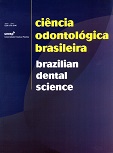Marginal leakage in permanent teeth after dentin treatment with air abrasion and adhesive systems
DOI:
https://doi.org/10.14295/bds.2007.v10i3.279Abstract
Due to doubts related to the application and association of techniques for appropriate adhesion, as the air abrasion system and last generation adhesive systems, the objective of this study was to evaluate the marginal leakage in Class V composite restorations in permanent teeth prepared with rotating instruments and then submitted to air abrasion and adhesive systems. Cavities were prepared with burs in high speed in facial and lingual surfaces of 25 human third molars. The specimens were divided into 5 groups of 10 preparations each: G1 (air abrasion and Scotchbond Multi Purpose), G2 (phosphoric acid and Scotchbond MP), G3 (Clearfil SE Bond self-etching system), G4 (air abrasion, phosphoric acid and Scotchbond MP) G5 (air abrasion and Clearfil SE Bond). All groups were restored with Z100 composite resin. The teeth were subjected to thermal cycling and immerged in 50% silver nitrate solution. After sectioning, the specimens were analyzed with a stereomicroscope for assessment of microleakage according to the degree of dye penetration. The Kruskal-Wallis test followed by Dunn Multiple Comparison test were performed in order to evaluate the differences among the experimental groups. Air abrasion groups demonstrated the greatest leakage. Scotchbond MP with phosphoric acid produced the least leakage, with greater leakage in gingival margins than occlusal margins in all experimental groups. It was concluded that dentin treatment with air abrasion should not be used in permanent teeth to reduce the marginal leakage.Downloads
Downloads
Published
How to Cite
Issue
Section
License
Brazilian Dental Science uses the Creative Commons (CC-BY 4.0) license, thus preserving the integrity of articles in an open access environment. The journal allows the author to retain publishing rights without restrictions.
=================




























